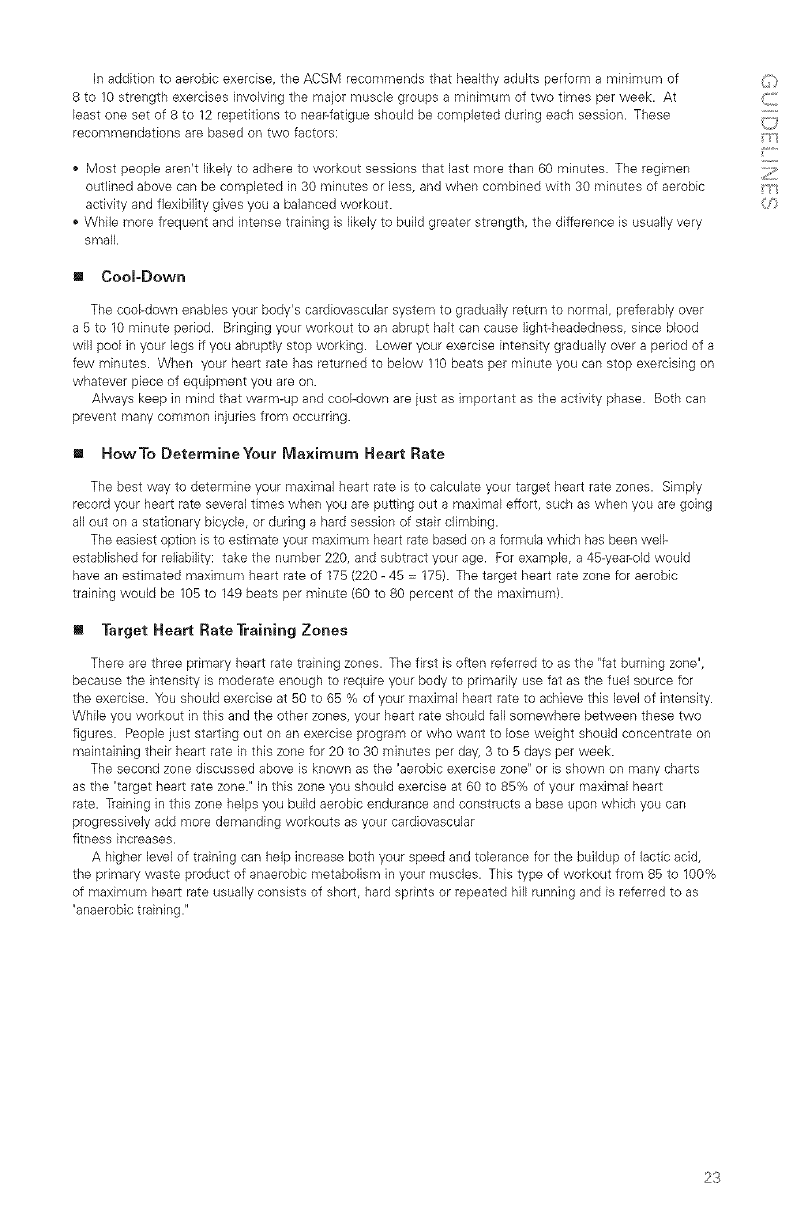
In addition to aerobic exercise, the ACSM recommends that healthy adults perform a minimum of
8 to 10 strength exercises involving the major muscle groups a minimum of two times per week. At
least one set of 8 to 12 repetitions to near-fatigue should be completed during each session. These
recomrrlendations are based on two factors:
Most people aren't likely to adhere to workout sessions that last more than 60 minutes. The regimen
outlined above can be completed in 30 minutes or less, and when combined with 30 minutes of aerobic
activity and flexibility gives you abalanced workout.
• While more frequent and intense training is likely to build greater strength, the difference is usually very
small.
! Cool-Down
The cool-down enables your body's cardiovascular system to gradually return to normal, preferably over
a 5 to 10 minute period. Bringing your workout to an abrupt halt can cause Iight-headedness, since blood
will pool inyour legs if you abruptly stop working. Lower your exercise intensity gradually over a period of a
few minutes. When your heart rate has returned to below 110 beats per minute you can stop exercising on
whatever piece of equipment you are on.
Always keep in mind that warm-up and cool-down are just as important as the activity phase. Both can
prevent many common injuries from occurring.
I! HowTo Determine¥our Maximum Heart Rate
The best way to determine your maximal heart rate isto calculate your target heart rate zones. Simply
record your heart rate several times when you are putting out a maximal effort, such aswhen you are going
all out on a stationary bicycle, or during a hard session of stair climbing.
The easiest option is to estimate your maximum heart rate based on a formula which has been well-
established for reliability: take the number 220, and subtract your age. For example, a 45-year-old would
have an estimated maximum heart rate of 175 (220 - 45 = 175). The target heart rate zone for aerobic
training would be 105to 149 beats per minute (60 to 80 percent of the maximum).
I! Target Heart RateTraining Zones
There are three primary heart rate training zones. The first is often referred to as the "fat burning zone",
because the intensity is moderate enough to require your body to primarily use fat as the fuel source for
the exercise. You should exercise at 50 to 65 % ef your maximal heart rate to achieve this level of intensity.
While you workout in this and the other zones, your heart rate should fall somewhere between these two
figures. People just starting out on an exercise program or who want to lose weight should concentrate on
maintaining their heart rate in this zone for 20 to 30 minutes per day, 3 to 5 days per week.
The second zone discussed above is known as the "aerobic exercise zone" or is shown on many charts
as the "target heart rate zone." In this zone you should exercise at 60 to 85% of your maximal heart
rate. Training in this zone helps you build aerobic endurance and constructs a base upon which you can
progressively add more demanding workouts as your cardiovascular
fitness increases.
A higher level of training can help increase both your speed and tolerance for the buildup of lactic acid,
the primary waste product of anaerobic metabolism in your muscles. This type of workout from 85 to 100%
of maximum heart rate usually consists of short, hard sprints or repeated hill running and is referred to as
"anaerobic training."
23


















